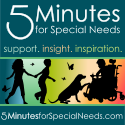Here is a one-pager that I shared with Bearhug's Pre-K teacher at a teacher meeting early in the school year. I created it to help frame up our discussion around Bearhug's strengths and challenges, and some things about autism / sensory issues to be aware of that would help her work with Bearhug more effectively.
I'm posting it here in case it helps gives other parents ideas for their own summary that could be used for parent-teacher discussions where appropriate.
Sources: Some of these are my own, others are adapted from a number of online sources, which I pulled together and tailored specifically to Bearhug's needs at the time. (It's been 4 years so I apologize, I can't remember the specific sources or I'd post links).
~~~~~~~~~~~~~~~~~~~~~~~~~~~~~~~~~~~
Strengths to be aware of:
• ‘Bearhug’ is very sweet-natured and tries really hard to do what he knows he is supposed to do.
• He loves to learn
• He has an excellent memory for numbers and visual things (he remembers even minute details of places he’s been, he can find his way around our town and nearby towns by sight)
• ‘Bearhug’ is usually good at sharing and is good at puzzles
Suggestions to help ‘Bearhug’ organize himself, learn effectively, and interact appropriately:
• Be positive and patient – understand that he IS trying very hard and encourage him
• Note strengths often and in a visual/physical way (he doesn’t always respond to verbal praise)
• He may need help with problem-solving situations, please be willing to take the time to help
• If an activity requires groups, please assign or use some arbitrary means of grouping to avoid him being left out
• Avoid verbal overload – keep directions short and simple, and/or use visual cues
• If he has difficulty learning a task, break it down into smaller steps or present in several different ways (visually, verbally, physically).
Areas of difficulty and suggestions to help:
• Transitions – having a picture schedule and some “prep” for an upcoming transition may help
• Routines – please try to give as much advance notice as possible if there will be any changes
• Social situations – he wants to make friends but doesn’t always know how to go about it
• At times, he may experience “meltdowns” when nothing may help behavior. At times like this, please allow a “safe and quiet spot” where he can calm down. Try to take note of what occurred before the meltdown, and it’s best to talk after the situation has calmed down.
• When you see anger or other outbursts, this is often a “fight/fright/flight” reaction. Prevention can sometimes head off situations if you see the warning signs coming.
• An increase in unusual or difficult behaviors probably indicate an increase in stress. Sometimes stress is caused by feeling a loss of control. Many times the stress will only be alleviated when he physically removes himself from the stressful event or situation.
Important things to be aware of:
• Many of his behaviors are NOT under his control and not a result of willful misbehavior. Usually misbehavior is the result of efforts to survive experiences which may be confusing, disorienting, or frightening.
• He is easily overstimulated and has difficulty filtering through sensory input, which makes him easily distracted. Too much sensory input with lots of other kids, chaos and noise can also stress him out so he may need a quiet place he can go to “take a break.”
• Sitting still for long periods of time can be very difficult, allowing him to move around, even for short intervals, will help him stay focused
• Often he can listen better if he’s not looking directly at you – lack of eye contact doesn’t mean he’s not paying attention
• Just because he learns something in one situation he doesn’t automatically mean that he remembers or is able to generalize the learning to new situations.
• If he covers his ears, this could indicate that a certain sound hurts his ears. He also sometimes does this when he’s afraid of something.
Read more >>
I'm posting it here in case it helps gives other parents ideas for their own summary that could be used for parent-teacher discussions where appropriate.
Sources: Some of these are my own, others are adapted from a number of online sources, which I pulled together and tailored specifically to Bearhug's needs at the time. (It's been 4 years so I apologize, I can't remember the specific sources or I'd post links).
~~~~~~~~~~~~~~~~~~~~~~~~~~~~~~~~~~~
Strengths to be aware of:
• ‘Bearhug’ is very sweet-natured and tries really hard to do what he knows he is supposed to do.
• He loves to learn
• He has an excellent memory for numbers and visual things (he remembers even minute details of places he’s been, he can find his way around our town and nearby towns by sight)
• ‘Bearhug’ is usually good at sharing and is good at puzzles
Suggestions to help ‘Bearhug’ organize himself, learn effectively, and interact appropriately:
• Be positive and patient – understand that he IS trying very hard and encourage him
• Note strengths often and in a visual/physical way (he doesn’t always respond to verbal praise)
• He may need help with problem-solving situations, please be willing to take the time to help
• If an activity requires groups, please assign or use some arbitrary means of grouping to avoid him being left out
• Avoid verbal overload – keep directions short and simple, and/or use visual cues
• If he has difficulty learning a task, break it down into smaller steps or present in several different ways (visually, verbally, physically).
Areas of difficulty and suggestions to help:
• Transitions – having a picture schedule and some “prep” for an upcoming transition may help
• Routines – please try to give as much advance notice as possible if there will be any changes
• Social situations – he wants to make friends but doesn’t always know how to go about it
• At times, he may experience “meltdowns” when nothing may help behavior. At times like this, please allow a “safe and quiet spot” where he can calm down. Try to take note of what occurred before the meltdown, and it’s best to talk after the situation has calmed down.
• When you see anger or other outbursts, this is often a “fight/fright/flight” reaction. Prevention can sometimes head off situations if you see the warning signs coming.
• An increase in unusual or difficult behaviors probably indicate an increase in stress. Sometimes stress is caused by feeling a loss of control. Many times the stress will only be alleviated when he physically removes himself from the stressful event or situation.
Important things to be aware of:
• Many of his behaviors are NOT under his control and not a result of willful misbehavior. Usually misbehavior is the result of efforts to survive experiences which may be confusing, disorienting, or frightening.
• He is easily overstimulated and has difficulty filtering through sensory input, which makes him easily distracted. Too much sensory input with lots of other kids, chaos and noise can also stress him out so he may need a quiet place he can go to “take a break.”
• Sitting still for long periods of time can be very difficult, allowing him to move around, even for short intervals, will help him stay focused
• Often he can listen better if he’s not looking directly at you – lack of eye contact doesn’t mean he’s not paying attention
• Just because he learns something in one situation he doesn’t automatically mean that he remembers or is able to generalize the learning to new situations.
• If he covers his ears, this could indicate that a certain sound hurts his ears. He also sometimes does this when he’s afraid of something.
























